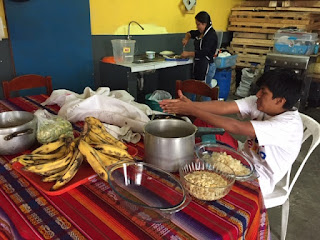As you can imagine in this predominantly Catholic country, Easter is a big deal. Palm Sunday and Good Friday are big deals as well. But nothing is a bigger deal, than Fanesca!
Fanesca is a thick soup cooked and eaten with families at home, or in restaurants throughout the season of Lent, and especially during the Easter, or Pascua, weekend. This traditional soup famously includes twelve different grains or legumes which represent the twelve apostles, and a dried salty fish which represents Jesus Christ. The addition of the fish definitely puts this soup into the category of an acquired taste, but like it or not, everyone agrees they at least have to have one bowl each year.
Last year for Easter, I enjoyed the very large public religious processions in Quito, but this year, I was lucky to experience more private Ecuadorian family Easter traditions. And in my Ecuadorian family, it is tradition to travel to Quito to the home of Margarita's parents, for the family recipe of Fanesca. So, we all gathered together on the morning of Good Friday to prepare the feast. Her parents, Maria and Gabriel, have a large warehouse room adjacent to their house, which sometimes is used to bake the extra bread for their bakery. It's also a great space for large family gatherings.
 |
| Here you can see that the choclo (corn) has already been shucked, the bananas will be sliced and fried and the habas (lima beans) will be added to the pot. |
 |
| Alex helped roast and shell the maní (peanuts), while I peeled the chochos (an edible lupine seed). |
 |
| Margarita peeled lots of papas (potatoes) for a side dish called Molo. |
 |
| Maria cleaned the bacalao (a very stinky dried fish). She admitted that she didn't like this job. |
 |
| When the cousins arrived, we started making prestiños, or fried dough to add to the top of the soup. |
Margarita's father, Gabriel, had prepared the dough in his bakery, but he gave me the official
baker's hat and apron to roll out the dough shapes.
Then we cooked the embellishments for the top: fried bananas, fried dough, hard boiled eggs,
and queso fresco cheese. Molo, or mashed potatoes, are also served on the side.










No comments:
Post a Comment